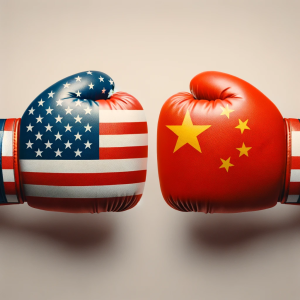The global economy has recently exhibited remarkable resilience. Despite what many would consider adverse conditions, it’s been defying expectations with a series of surprising developments. Notably, the United States, in the face of the most aggressive monetary tightening since the 1980s, experienced an acceleration in economic growth in 2023 and this will be difficult to achieve in economy of 2024. This growth came as a pleasant surprise to many observers, countering the pessimistic forecasts that dominated headlines earlier.
Similarly, Europe, in an impressive feat, managed to significantly reduce its dependence on Russian gas. This shift, which many feared would lead to severe economic consequences, was accomplished relatively smoothly, averting the anticipated economic crisis. This is a testament to Europe’s adaptive capabilities and strategic resource management.
Inflation, a key concern globally, has shown a declining trend without the typical accompanying rise in unemployment rates. Interestingly, this stabilization in the job market seems to be more a result of a decrease in job vacancies rather than an increase in job losses. This unique scenario has emboldened optimists who predicted a “soft landing” for the economy 2024, and their predictions appear to be materializing.
However, as we look toward 2024, the global economic landscape remains fraught with uncertainty and challenges. Inflation, while lower than previous years, is expected to linger at uncomfortably high levels. This persistent inflation poses a continuous challenge to economic policy, requiring a delicate balance between stimulating growth and controlling price rises.
 The United States, a primary engine of global economic growth, may continue to avoid a recession, but the situation in other parts of the world is more precarious. The decline in inflation has brought temporary relief, particularly to central bankers. Yet, in major economies, the trajectory back to the ideal 2% inflation target appears unlikely without a recessionary phase. Labor markets in these economies remain robust, and nominal wage growth is still high, factors that traditionally put upward pressure on inflation. Additionally, the global economy now has to contend with the repercussions of more expensive oil. After a period of relative stability following the pandemic and Russia’s invasion of Ukraine, oil prices have surged, partly due to production cuts by major oil-producing countries and geopolitical incidents, such as the recent Hamas attack on Israel. This rise in oil prices could trigger fears of a “second wave” of inflation.
The United States, a primary engine of global economic growth, may continue to avoid a recession, but the situation in other parts of the world is more precarious. The decline in inflation has brought temporary relief, particularly to central bankers. Yet, in major economies, the trajectory back to the ideal 2% inflation target appears unlikely without a recessionary phase. Labor markets in these economies remain robust, and nominal wage growth is still high, factors that traditionally put upward pressure on inflation. Additionally, the global economy now has to contend with the repercussions of more expensive oil. After a period of relative stability following the pandemic and Russia’s invasion of Ukraine, oil prices have surged, partly due to production cuts by major oil-producing countries and geopolitical incidents, such as the recent Hamas attack on Israel. This rise in oil prices could trigger fears of a “second wave” of inflation.
In response to these developments, major central banks are likely to adopt a cautious approach. They might refrain from further interest rate hikes, interpreting any oil-driven inflation as a temporary phenomenon. However, they are equally likely to avoid cutting rates too soon, fearing that such a move might be premature.
In America, the economy’s resilience is underpinned by extraordinarily high levels of government borrowing. The federal government’s deficit is running at a rate of over 7% of GDP. This raises a critical question about the future of interest rates and whether we are entering a new norm of ‘higher-for-longer’ rates. Much of this will depend on the continuation of the government’s borrowing trend, which is likely to persist, especially in the face of an upcoming presidential election. The next occupant of the White House will likely have to address the issue of renewing Donald Trump’s 2018 tax cuts, which are set to expire in 2025. Even Democrats may be hesitant to let these cuts lapse entirely, indicating a continuation of the current fiscal policy.
 Outside the United States, the picture is less rosy. Europe, for instance, appears to be on the brink of a recession. The Eurozone’s economy, already fragile, might be pushed over the edge by high interest rates, and inflation fears could prevent policymakers from responding effectively. In Asia, China’s economic slowdown is a significant cause for concern. Whether China can rebound and avoid a Japan-like prolonged stagnation depends heavily on its government’s willingness to open the fiscal taps. However, recent shifts in China’s economic policy, including the end of its zero-COVID policy and crackdowns on technology firms, suggest that any stimulus may not be as effective as hoped. Additionally, the high indebtedness of local governments in China imposes fiscal constraints that further complicate the economic outlook.
Outside the United States, the picture is less rosy. Europe, for instance, appears to be on the brink of a recession. The Eurozone’s economy, already fragile, might be pushed over the edge by high interest rates, and inflation fears could prevent policymakers from responding effectively. In Asia, China’s economic slowdown is a significant cause for concern. Whether China can rebound and avoid a Japan-like prolonged stagnation depends heavily on its government’s willingness to open the fiscal taps. However, recent shifts in China’s economic policy, including the end of its zero-COVID policy and crackdowns on technology firms, suggest that any stimulus may not be as effective as hoped. Additionally, the high indebtedness of local governments in China imposes fiscal constraints that further complicate the economic outlook.
Moreover, the gradual increase in geopolitical tensions, particularly between America and China, along with a rising tide of global protectionism, is adding complexity to international trade dynamics. The number of protectionist measures has risen dramatically over the past decade, which, while benefiting some Asian economies due to the relocation of supply chains from China, also results in duplication of investments and loss of efficiency from specialization. This is likely to dampen the potential growth of the global economy 2024. Even fast-growing economies like India, which benefit from these shifts, show an alarming trend towards more insular economic policies.
Furthermore, less affluent countries face their own unique set of challenges. High indebtedness, low growth rates, and the impact of a strong dollar are significant hurdles. The International Monetary Fund (IMF) will likely continue to grapple with providing effective debt relief to countries heavily indebted to China and other non-traditional lenders, who do not adhere to established principles for debt restructuring.
The potential reelection of Donald Trump to the U.S. presidency in 2024 adds another layer of uncertainty to this already complex global economic landscape. A second term for Trump could mean deeper tax cuts, potentially leading to even larger deficits, and a further intensification of trade conflicts. These policy shifts, while they might initially boost stock markets, as they did in 2016, could have long-term destabilizing effects on both the U.S. and global economies.
Trump’s economic policies, characterized by aggressive tax cuts and a confrontational stance on trade, could exacerbate the existing trends of protectionism and economic nationalism. This could lead to a further fragmentation of global trade networks, undermining the benefits of globalization and potentially slowing down global economic growth.
 In addition, Trump’s return to the White House could amplify geopolitical tensions, particularly with China. This would not only impact bilateral relations but could also have broader implications for international trade and economic cooperation. The global economy, already navigating the complexities of post-pandemic recovery and geopolitical shifts, might find itself facing increased uncertainty and risk.
In addition, Trump’s return to the White House could amplify geopolitical tensions, particularly with China. This would not only impact bilateral relations but could also have broader implications for international trade and economic cooperation. The global economy, already navigating the complexities of post-pandemic recovery and geopolitical shifts, might find itself facing increased uncertainty and risk.
The impact of these global economic trends is not just limited to the major economies but also extends to developing countries. Many of these nations are already struggling with the consequences of high debt levels, low growth, and the effects of a strong U.S. dollar. A further escalation in global economic turbulence could exacerbate their challenges, potentially leading to more widespread financial instability and socio-economic difficulties making economy 2024 much more challenging.
Moreover, the ongoing shift towards protectionism and the potential for increased economic isolationism could have significant consequences for global supply chains. The shift could lead to increased costs, reduced efficiency, and disruptions in the flow of goods and services worldwide. This would particularly impact industries that rely heavily on global supply chains, such as technology, automotive, and manufacturing sectors.
The overall global economy 2024, therefore, appears to be one of continued complexity and uncertainty. While the world economy has shown remarkable resilience in the face of multiple challenges, the path ahead is fraught with potential obstacles and risks. Policymakers, businesses, and individuals alike will need to navigate this landscape with caution and adaptability, as the world economy continues to evolve in an increasingly interconnected and dynamic global environment.
